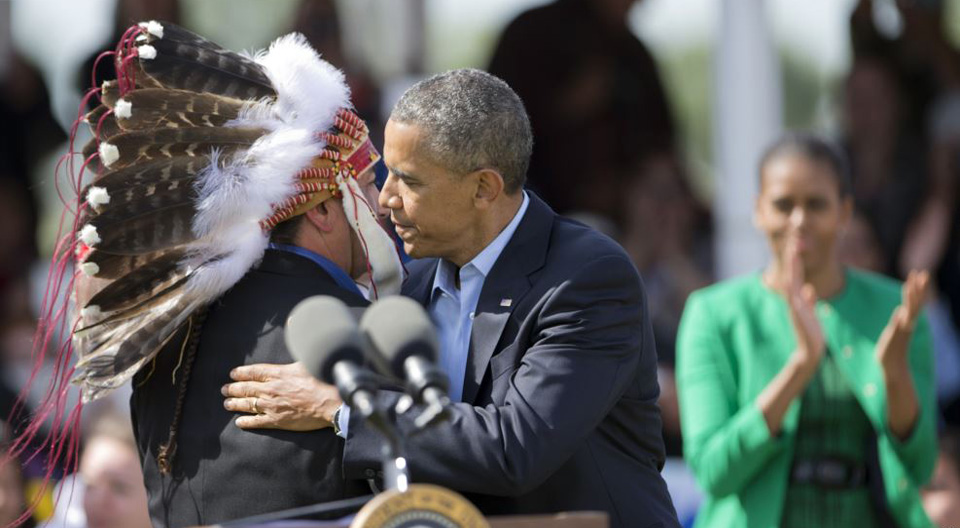
The U.S. Army Corps of Engineers announced Dec. 4 that it will not be granting the easement that would allow the proposed Dakota Access Pipeline to cross under the Missouri River at Lake Oahe. The Corps will be undertaking an environmental impact statement to look at possible alternative routes.
This important, if temporary, victory in the battle to prevent the ill-conceived pipeline from being built underneath a source of drinking water for thousands in North Dakota and beyond certainly belongs to the Standing Rock Sioux Tribe, the Native American water protectors, and their many supporters around the world.
Since the spring, the tribe has attempted to rouse the entire nation to the dangers inherent in the project. It threatens drinking water, carves up sacred Native sites, demolishes tribal sovereignty rights, and continues the over-reliance on dirty fossil fuels. It would benefit not the nation’s economy, but the profit margins of corporations (Energy Transfer Partners and Sunoco Logistics Partners). What is more, it would exacerbate human-induced climate change — something we cannot afford to do
The tribe and their supporters won over a powerful ally for the cause in the president of the United States of America, Barack Obama. Obama, going up against long-entrenched Big Oil and Big Coal corporate and political interests, has led the nation in addressing climate change. He has reached out to the Native and Indigenous communities throughout the U.S., like no other president in history. History and politics set that bar low for both of those areas, however it takes vision and democratic sensibility to go against precedent and set a new standard.
As Standing Rock Sioux Tribal Chairman Dave Archambault II, the man who elevated the pipeline struggle to a national and international level, said in his statement, “We wholeheartedly support the decision of the administration and commend with the utmost gratitude the courage it took on the part of President Obama, the Army Corps, the Department of Justice, and the Department of the Interior to take steps to correct the course of history and to do the right thing.
“The Standing Rock Sioux Tribe and all of Indian Country will be forever grateful to the Obama Administration for this historic decision.”
But this historic decision, a cause for celebration among the thousands who populate the Oceti Sakowin and other water protector encampments in Cannon Ball, N.D., may not stand with the incoming Trump administration. Trump has expressed support for the pipeline. He, in fact, had been an investor in Energy Transfer Partners, owning between $500,000 and $1 million worth of shares, according to 2015 campaign disclosure reports.
ETP and its partner corporations are under pressure to finish the pipeline by Jan. 1 or risk financial loss, according to a recent energy economics report. ETP’s CEO, Kelcy Warren, donated $100,000 to the Trump Victory Fund, and Trump has promised to “unleash America’s $50 trillion in untapped shale, oil, and natural gas reserves, plus hundreds of years in clean (sic) coal reserves.” He has executives from Exxon Mobil and other energy corporations on the short list for secretaries of State, Interior, and Energy.
His meeting with former vice president and climate change expert Al Gore notwithstanding, the probability of Trump rolling back the Corps’ decision is high. His predilection for Big Oil and racism, for enriching himself and his cronies and punishing his enemies, makes it almost a certainty. For Trump, it doesn’t matter that the current infrastructure for North Dakota’s Bakken oil region has enough capacity without this pipeline, given the realities of oil prices and expected production decrease, according to the Institute for Energy Economics and Financial Analysis report. And in the long run, that does not bode well for meaningful long-term job creation.
ETP and its pipeline partners, which include Phillips 66, Sunoco, Tesoro and Hess, as well as a $476 million investment from Wells Fargo, have had North Dakota’s governor, law enforcement on their side. But starting Jan. 20, 2017, the White House seems poised to join with the pipeline proponents. Wealth and state power may seem insurmountable, but history is full of victories that the people have won through organizing.
It is a good sign that local and federal law enforcement agents have begun removing blockades that have kept water protectors away from the construction areas. But the water protectors are urging vigilance because of Trump’s energy agenda and the fact that ETP has already said it plans to defy the Corps’s denial of easement and continue building the pipeline along its planned route. Trump’s proposed head for the Environmental Protection Agency, Scott Pruitt, a climate change denier who wants to undo all of Obama’s regulations on Big Coal and Big Oil corporations, is another dangerous signal that this victory is precarious.
In urging the public to send a thank you to the president, the Lakota Law Project said ETP already has a lawsuit pending against the Army Corps of Engineers. Calls to your U.S. senators are critical. Tell them you support President Obama and the Corps’ decision to deny the pipeline permit. Any nominee for relevant Cabinet and other positions must not reverse it.










